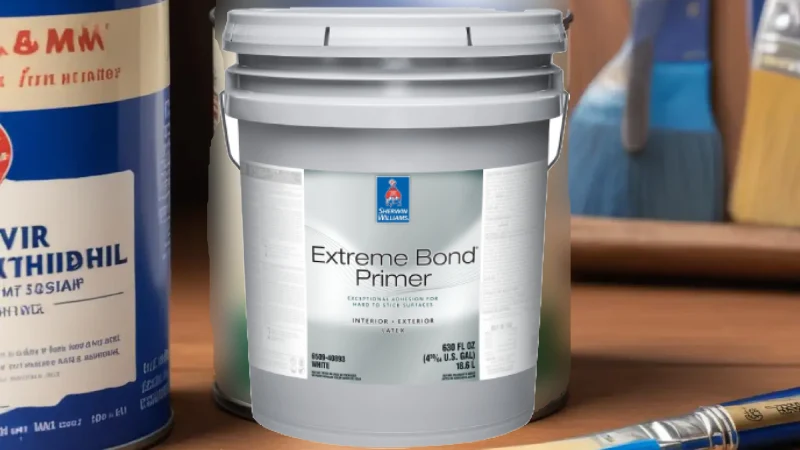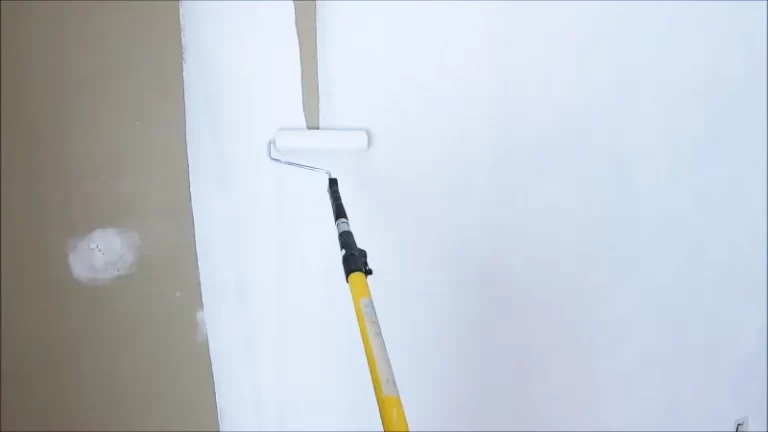Sherwin Williams Extreme Bond Primer: The Ultimate Review for Surfaces That Won’t Stick
You’ve faced the frustration. You spend hours, even days, prepping a surface, only to watch in horror as your fresh coat of paint peels, chips, or scratches off with the slightest touch. It’s a painter’s worst nightmare, and it happens most often on slick, glossy, or otherwise stubborn surfaces.
From laminate cabinets and ceramic tile to glass and old oil-based paints, some materials just seem to defy adhesion. This is where a specialty primer becomes not just a recommendation, but an absolute necessity. Enter Sherwin-Williams Extreme Bond Primer, a product designed specifically to tackle these nightmare scenarios.
You'll Learn About
What is Sherwin-Williams Extreme Bond Primer and How Does It Work?
Extreme Bond Primer is a high-quality, water-based primer formulated to adhere to the toughest surfaces. Unlike standard primers that rely on penetrating a porous surface, this one is engineered to create a tenacious grip on hard, non-porous materials. Its urethane-modified acrylic formula promotes exceptional adhesion where other primers would fail.
Think of it as the ultimate peacemaker between a difficult surface and your final coat of paint. It creates a stable, uniform foundation that your topcoat can securely grab onto, ensuring a durable and long-lasting finish. This means less time sanding and more time enjoying your newly transformed space.
The Nightmare Surfaces: Where This Primer Shines
This primer’s main purpose is to solve problems on surfaces that are notoriously hard to paint. Professionals and DIYers have found success using it on a variety of challenging materials, turning seemingly impossible projects into stunning successes.
Taming the Slick Beast: Painting Laminate and Melamine Furniture
Giving a facelift to dated kitchen cabinets or a laminate bookshelf is one of the most common projects where this primer excels. These surfaces are non-porous and glossy, making them a prime candidate for paint failure. Users report that with proper cleaning and a light scuff sanding, Extreme Bond Primer provides an excellent base for paint on cabinets, leading to a durable, scratch-resistant finish.
A Modern Facelift: Can You Really Paint Ceramic Tile?
Painting over old ceramic tile on a backsplash or bathroom wall can save thousands on a remodel. Extreme Bond Primer makes this possible by adhering directly to the glazed surface. For best results, the tile must be impeccably clean and scuffed to dull the gloss, but this primer creates the bond needed for a lasting paint job in low-moisture areas.
It is important to note this product is not recommended for areas subject to excessive water, like inside a shower or around sinks. For exterior projects that need a sound surface, sometimes a more aggressive approach like pressure washing paint off stucco is necessary before any priming can begin.
From Glossy to Gorgeous: Conquering Old Oil-Based Paint
One of the biggest headaches for homeowners is dealing with old trim and doors coated in high-gloss, oil-based paint. Painting directly over it with latex paint is a recipe for disaster. While the technical data sheet still recommends sanding glossy surfaces for maximum adhesion, many professional painters have used this primer over properly cleaned, old oil-based paint with great success, even without extensive sanding.
Unexpected Adhesion: Glass, PVC, and Other Plastics
The versatility of Extreme Bond Primer extends to even more unusual surfaces. It has been designed for use on glass panels, PVC piping, vinyl, and fiberglass. This makes it a valuable tool for a wide range of commercial and residential projects where conventional primers would be ineffective.
The Ultimate Application Guide: Step-by-Step for a Flawless Finish
Even the best primer in the world will fail without proper surface preparation. Following these steps is crucial to unlocking the full potential of Extreme Bond Primer and ensuring your paint job stands the test of time.

Step 1: Surface Preparation is Everything
First, clean the surface thoroughly. All grease, oil, soap residue, and contaminants must be removed. Use a good quality degreasing cleaner, rinse well, and allow the surface to dry completely. For something like stubborn, old paint on metal, you might even need to consider methods like those used to remove paint from aluminum window frames before you can even think about priming.
Next, scuff sand the surface. While Sherwin-Williams states that sanding may not be necessary for most clean surfaces, their own technical data sheets and countless professional painter reviews confirm that you get the best results by dulling any glossy surface. A light sanding with 120-180 grit sandpaper creates a microscopic profile, or “tooth,” for the primer to grip even more effectively. After sanding, wipe away all dust with a tack cloth or a damp rag.
Step 2: Applying the Primer
This primer can be applied with a brush, roller, or sprayer. It is known for being quite thin, which helps it lay down flat but can also lead to runs if applied too heavily. The key is to apply one thin, even coat. Do not over-apply in an attempt to get better coverage; the goal is adhesion, not hiding power.
Step 3: Dry Times and Recoating
Extreme Bond Primer dries quickly. It is typically dry to the touch in 30 minutes and can be recoated with a topcoat in about one hour. However, it’s critical to understand the difference between “dry” and “cured.” Full adhesion and hardness can take several days, so be gentle with the newly primed surface and avoid subjecting it to harsh use immediately.
Sherwin Williams Extreme Bond Primer Reviews: What Real Users Say
Online forums and product review sections are filled with experiences from both professional painters and DIY enthusiasts. A clear picture emerges of a powerful but specific-use product.
The Good: Unbelievable Adhesion and Time-Saving
The overwhelming majority of positive reviews praise the primer’s incredible bonding capabilities. Users are consistently impressed with how well it sticks to slick surfaces after other products have failed. Many professionals highlight that it “passed the fingernail test” shortly after drying, meaning it couldn’t be easily scratched off.
The Bad: Common Pitfalls and Complaints
Nearly every negative review can be traced back to one of two issues: improper prep or unrealistic expectations. Some users have reported cracking or peeling, but this can occur when applying the primer too thickly or over a surface that wasn’t cleaned properly. It’s also important to note that this is a bonding primer, not a stain-blocking primer. For heavy stains or wood tannins, a dedicated stain-blocking primer may be needed first.
The Ugly: When to AVOID This Primer
This is not a cure-all for every paint problem. Do not apply it over actively peeling or failing paint; you must scrape and sand to a sound surface first. It’s also not intended for use on floors or in areas with constant water exposure. Additionally, extreme heat or humidity can affect its performance, much like how it can cause issues like paint melting or improper curing.
Extreme Bond Primer vs. Other Primer Types
Understanding where Extreme Bond fits in the primer landscape is key. It’s a specialty product, not a replacement for everyday multi-purpose primers.
| Primer Type | Best For | Pros | Cons |
|---|---|---|---|
| Extreme Bond Primer | Slick, glossy surfaces (laminate, tile, glass, oil paint) | Exceptional adhesion, fast dry time, water cleanup | Not a stain blocker, can be expensive, requires clean surfaces |
| Latex Multi-Purpose Primer | Drywall, softwood, previously painted surfaces | Easy to use, low odor, flexible | Poor adhesion on glossy surfaces, poor stain blocking |
| Oil-Based / Shellac Primer | Heavy stains (water, smoke), wood tannins, sealing odors | Excellent stain blocking and adhesion | Strong odor, requires mineral spirits/alcohol for cleanup, can be brittle |
| Peel Bonding Primer | Chalky surfaces, peeling paint (after scraping/sanding) | Glues down edges of peeling paint, remains flexible | Very thick, not for slick surfaces |
Frequently Asked Questions (FAQ)
Do I absolutely have to sand before using Extreme Bond Primer?
While the product can says sanding may not be necessary, the technical data sheet and professionals strongly recommend you dull all glossy surfaces with a light sanding for maximum adhesion and the best possible outcome.
How durable is it on kitchen cabinets?
When applied correctly over a properly prepped surface and followed by a high-quality topcoat like Sherwin-Williams Emerald Urethane Trim Enamel, it creates a very durable system suitable for the wear and tear of a kitchen.
Can I use it on exterior surfaces?
Yes, it is rated for both interior and exterior use. However, for large pre-finished metal surfaces like siding, Sherwin-Williams recommends their DTM Bonding Primer instead.
The Final Verdict: Is Sherwin-Williams Extreme Bond Primer Worth the Cost?
Sherwin-Williams Extreme Bond Primer is not your everyday drywall primer, and it comes with a premium price tag. However, when faced with a challenging, hard-to-stick surface, its value becomes immediately apparent. It is a problem-solving product that can save a project from complete failure.
For cabinets, tile, laminate, or painting over old glossy oil paint, it is an absolute game-changer. The key to success lies in meticulous preparation. Clean, dull, and dry—these are the three commandments. When used correctly for its intended purpose, Extreme Bond Primer is more than worth the cost; it’s the insurance policy your paint job needs to succeed.

